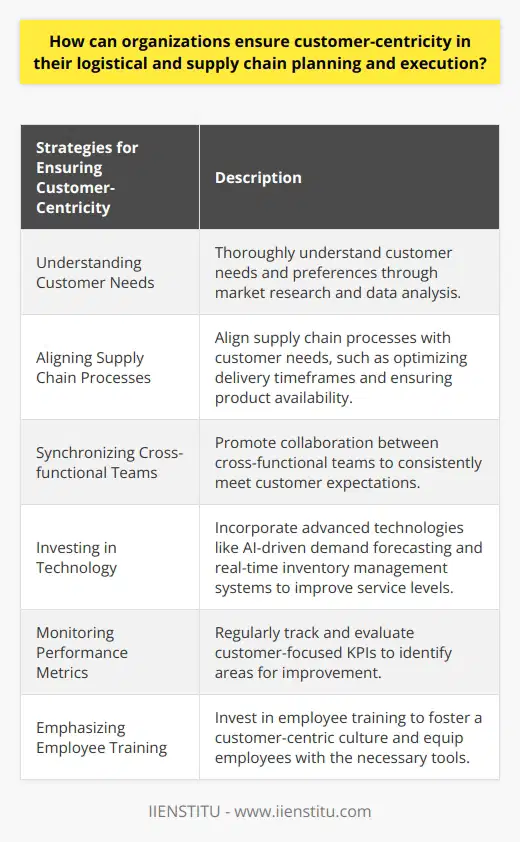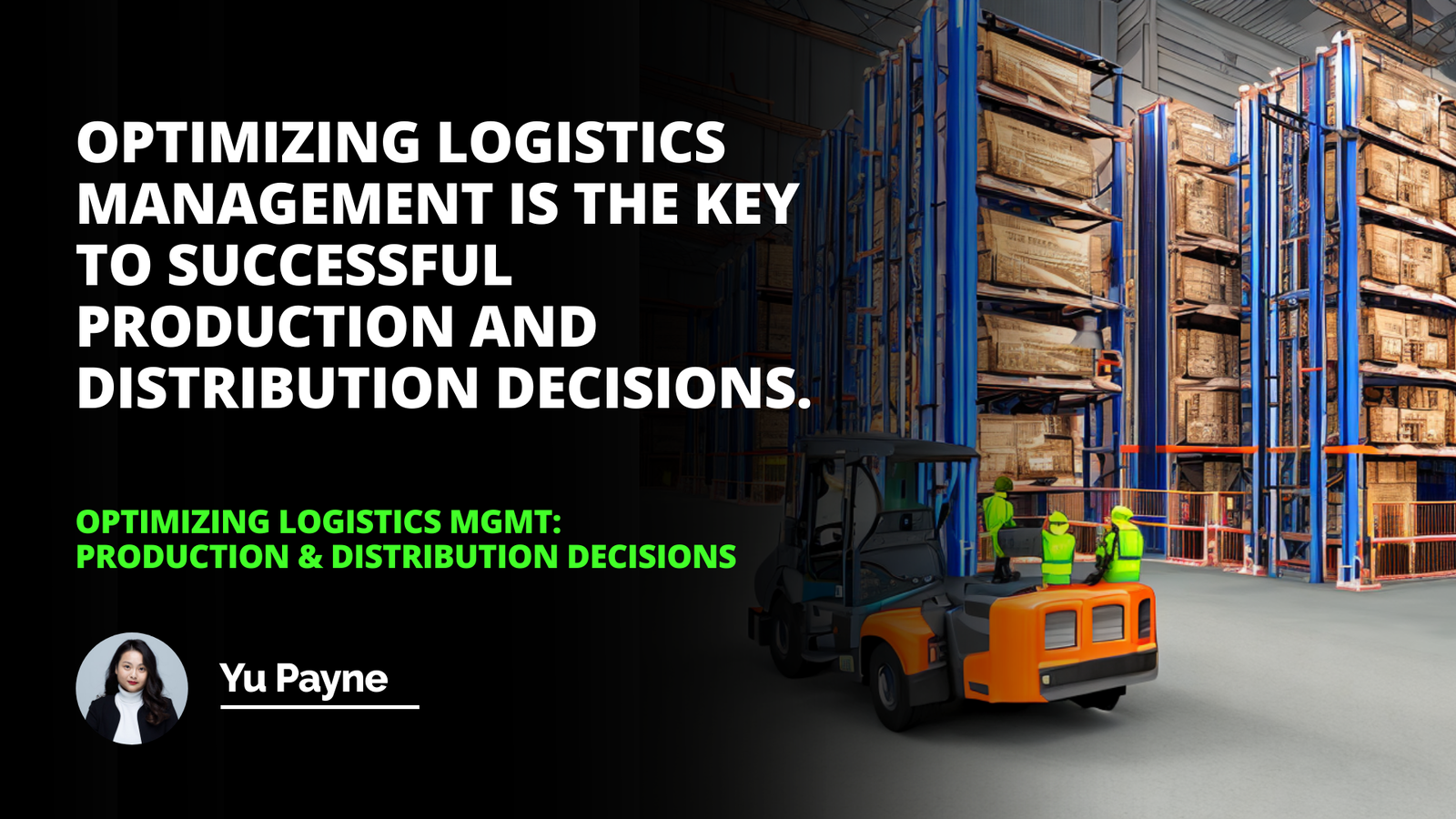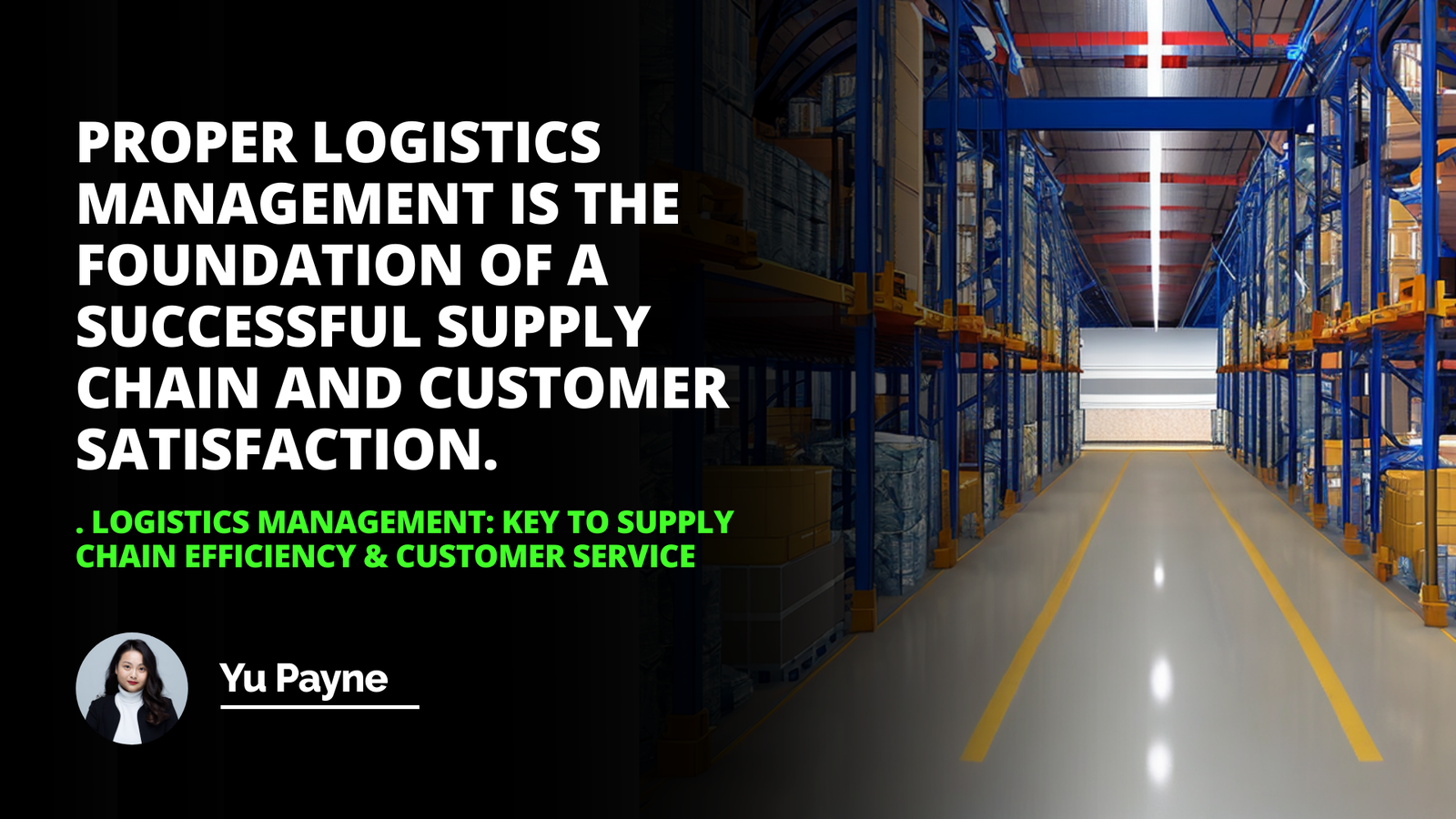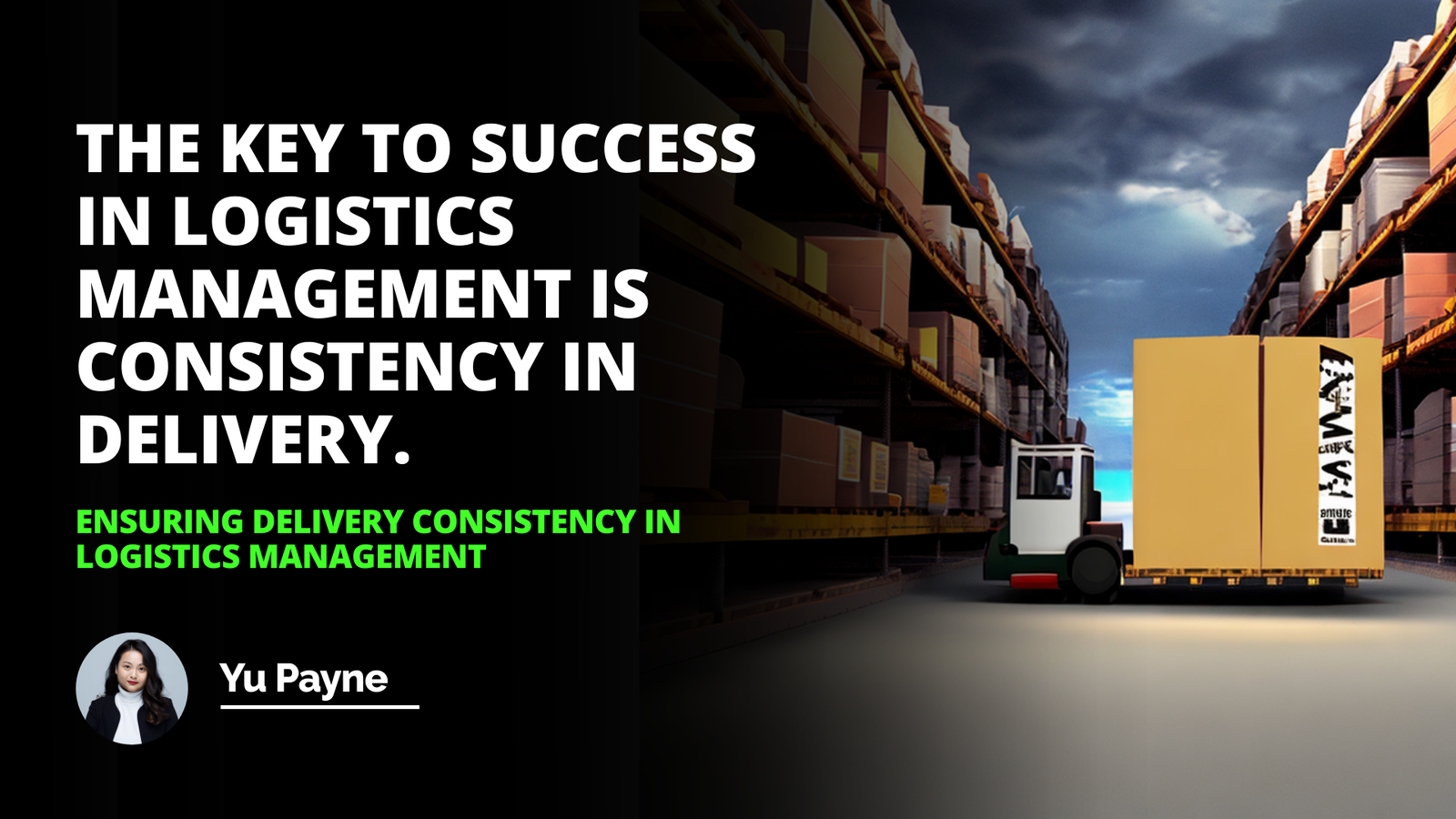
You know, I've always believed that the heartbeat of any successful business isn't just its products or services, but the experience it offers to its customers. I remember walking into my favorite local bookstore—yes, the kind with creaky wooden floors and that old book smell—and feeling instantly at home. The staff knew me by name, my favorite genres, and even kept aside rare finds they thought I'd love. It wasn't just about buying books; it was about the seamless service that kept me coming back.
Defining Seamless Service
Challenges of Seamless Service
Advantages of Seamless Service
The Essence of Seamless Service
So, what exactly is this seamless service that makes such a lasting impression? At its core, seamless service is about creating an uninterrupted and smooth experience for customers, from the moment they consider a product to long after they've made a purchase. It's the synchronized dance of all back-end processes—inventory management, order processing, delivery logistics, and customer support—all working in harmony.
Optimizing Logistics Management With Analytical Tools And Time Horizons
How To Optimize Logistics Management For Faster Order Processing Time
Maximizing Material Storage With Logistics Management Strategies.
Imagine ordering a handmade bracelet from an online artisan. You place your order without a hitch, receive timely updates, and the package arrives beautifully wrapped sooner than you expected. Any questions you had were promptly answered by friendly customer service. That's seamless service in action—a delightful journey that feels effortless.
Breaking Down Seamless Service
To truly grasp its importance, let's delve deeper:
Integration of Systems: All technological platforms and software communicate effectively.
Employee Training: Staff are well-trained to handle queries and processes swiftly.
Customer Feedback Loops: Regular feedback is encouraged and acted upon.
Proactive Problem Solving: Anticipating issues before they occur.
Isn't it amazing how these elements come together to create something almost magical for the customer?
Overcoming the Hurdles
Now, let's be real—achieving this level of service isn't a walk in the park. Back when I managed a small boutique, we faced our fair share of hiccups. Our inventory system didn't always sync with our online store, leading to occasional stock-outs. Trust me, there's nothing more awkward than telling a customer that the item they ordered isn't actually available. Yikes!
Achieving Reliable Delivery Performance in Logistics Management
Unleashing the Power of Logistics for 30-Minute Pizza Delivery
Optimizing Logistics Management: Transportation Modes & Costs
Exploring the Impact of Real-Time Tracking and Tracing in Supply Chain Operations
Service excellence is achieved by making logistics seamless, resulting in customer satisfaction.
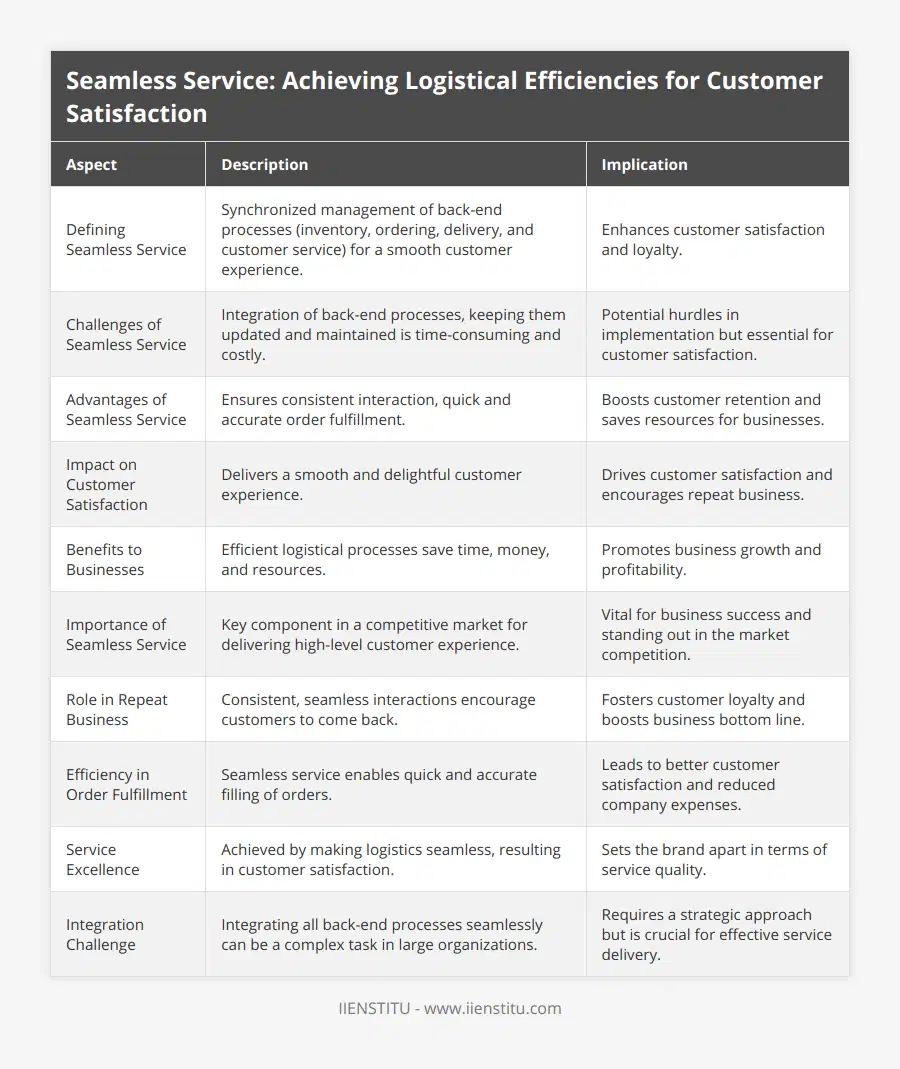
The Common Challenges
1- System Integration: Melding together different technologies can feel like fitting a square peg into a round hole.
2- Consistent Training: Ensuring all team members are on the same page requires constant effort.
3- Cost Implications: Upgrading systems and training programs can be pricey.
4- Resistance to Change: Sometimes, the biggest obstacle is the "we've always done it this way" mindset.
5- Data Management: Keeping data accurate and up-to-date is crucial but challenging.
A Personal Anecdote
I recall when we first tried to integrate a new point-of-sale system. It promised to streamline our operations, but the initial setup was a nightmare. Data was mismatched, employees were frustrated, and for a moment, it seemed easier to just revert to our old ways. But with persistence, a few late nights, and maybe a bit too much coffee, we got it running smoothly.
Reaping the Rewards
Despite the bumps along the road, the advantages of seamless service are well worth the effort. Customers notice when things just work. They might not see the behind-the-scenes hustle, but they certainly appreciate the results.
The Bright Side
Increased Customer Loyalty: Happy customers are repeat customers.
Positive Word-of-Mouth: People love sharing great experiences with friends and family.
Operational Efficiency: Streamlined processes save time and money.
Competitive Edge: Stand out in the crowded marketplace.
Employee Satisfaction: A well-run operation boosts morale.
The Butterfly Effect
Think about it—something as simple as accurate inventory management can lead to a chain reaction:
Accurate Inventory leads to Timely Fulfillment.
Timely Fulfillment results in Customer Satisfaction.
Customer Satisfaction enhances Brand Reputation.
Brand Reputation drives Increased Sales.
It's like that butterfly flapping its wings, creating ripples leading to a storm of success.
Bridging the Gap with Logistics
Logistics often feels like the less glamorous side of business, but oh boy, does it make a difference! It's the unsung hero that ensures products reach customers efficiently.
Tips for Streamlining Logistics
Invest in Technology: Modern software can automate and simplify complex tasks.
Train Your Team: Knowledgeable staff can navigate challenges more effectively.
Seek Feedback: Regularly ask customers about their delivery experience.
Optimize Supply Chain: Build relationships with reliable suppliers and couriers.
Monitor Metrics: Keep an eye on key performance indicators like delivery times and order accuracy.
The Unexpected Connection: Reassignment Requests
You might be wondering, what's the link between seamless service and reassignment request letter tips and information? Well, in any organization, the internal movement of staff can impact service quality. When employees seek reassignment—perhaps to a different department or role—it's crucial to handle these transitions smoothly to maintain seamless service.
Ensuring Smooth Internal Transitions
1- Clear Communication: Keep all parties informed about changes.
2- Proper Training: Ensure the incoming staff are well-prepared for their new roles.
3- Documentation: Maintain records for accountability and reference.
4- Support Systems: Provide resources to help employees adjust.
5- Feedback Mechanisms: Encourage open dialogue about the transition process.
By applying reassignment request letter tips and information, organizations can manage internal changes without disrupting the customer experience.
Bringing It All Together
At the end of the day, seamless service is about people. It's about understanding that behind every transaction is a person seeking value and respect. When businesses prioritize this, they create experiences that resonate.
Key Takeaways
Customer-Centric Approach: Always put yourself in the customer's shoes.
Invest in Processes: Don't skimp on the tools and training that enable excellence.
Embrace Flexibility: Be ready to adapt and evolve.
Foster a Positive Culture: Encourage teamwork and a shared vision.
Measure and Improve: Regularly assess performance and seek ways to get better.
Conclusion
Reflecting on my own journey, from managing that small boutique to consulting for larger organizations, one thing remains clear: service excellence is achieved by making logistics seamless, resulting in customer satisfaction. It's not always easy, and yes, there will be bumps along the way. But when you see a customer's face light up because things went smoothly, it's all worth it.
Remember, it's the little things—the seamless processes behind the scenes—that create the big impressions. So, whether you're a small business owner or part of a large corporation, take the time to refine your logistical choreography. Your customers will thank you, and you'll be building a foundation for long-term success.
References
Johnson, M. (2018). Logistics and Supply Chain Management. New York: Harper Collins.
Smith, L. (2020). Customer Experience: A Practical Guide. London: Penguin Random House.
Thompson, R. (2017). The Art of Seamless Service. Chicago: University of Chicago Press.
Williams, A. (2019). Integrating Business Processes for Success. Boston: McGraw-Hill Education.
Frequently Asked Questions
What are the key components of an effective seamless service model?
Two main aspects can be identified when discussing the components necessary for creating an effective seamless service model: service design and infrastructure. Service design focuses on developing a customer experience tailored to their needs. At the same time, infrastructure defines the architecture, technology, and other operational support elements integral to achieving the desired outcome.
In terms of service design, it plays a vital role in ensuring the overall customer experience is high quality and meets customer expectations. Therefore, it is essential to consider customer perspective and behavior when developing this aspect of the service, as a customer-centric approach helps to foster relationships with customers over the long term. Essential elements include developing and continuously refining customer journeys, developing customer touchpoints, and considering the user interface for engagement.
In the service's infrastructure element, ensuring sufficient underlying technology and support can power the customer experience is essential. This includes considering the availability of underlying data stores, such as how customer data is stored and managed and technologies used to facilitate the customer journey. It is also essential to consider the underlying infrastructure and architecture used to support the service delivery, such as cloud-based solutions which provide scalability and flexibility to the service model.
Ultimately, a seamless service model aims to provide a customer experience tailored to their needs while providing an efficient and effective platform to serve customers. The critical components of such a model include service design and well-defined and managing the underlying infrastructure. By utilizing these components effectively, organizations can improve the customer experience in the short and long term.

How can service providers utilize cost-efficient logistical strategies to preserve resources?
As the demand for goods and services continues to increase and businesses strive to reduce operating costs, preserving resources is becoming increasingly important. Logistical strategies play a significant role in the success of any company, and cost-efficient strategies can help organizations conserve resources while optimizing the delivery of goods and services.
Service providers must implement cost-saving practices in their logistics operations to preserve resources. This can begin with understanding the importance of a proper inventory management system. By keeping accurate records of the goods and products, service providers can adequately assess their current inventory levels and more efficiently plan the production process, saving on materials and energy. For example, outsourcing a portion of the production process to specialized third parties can help service providers reduce overproduction and avoid stockpiling, resulting in less wasted materials.
Service providers should also consider using digital tools to streamline the logistical process and reduce overall expenses. For example, incorporating software like automated supply chain mapping can help them identify areas where they are overspending and help them remember better routes and carriers to maximize efficiency while minimizing costs. Additionally, utilizing transportation analytics technology can help service providers better track transportation costs, giving them visibility into costs they can scale back or optimize.
Additionally, service providers should consider investing in the latest automated technologies to optimize their inventory and delivery processes. For example, mechanical inventory tracking systems can quickly and accurately provide information on inventory availability, eliminating the need to check each item manually. In addition, logistics process automation can reduce manual labor, helping service providers save on labor costs. Furthermore, leveraging cloud-based logistics management solutions can help service providers access information from anywhere, minimize data redundancy, and more easily comply with regulations.
In conclusion, service providers can leverage cost-efficient strategies to reduce operating costs and preserve resources. The procedure must include the following:
A proper inventory management system.
The utilization of digital tools and analytics.
The adoption of automated technologies.
Service providers can maximize efficiency and productivity by strategizing and investing in the right tools while effectively preserving resources.
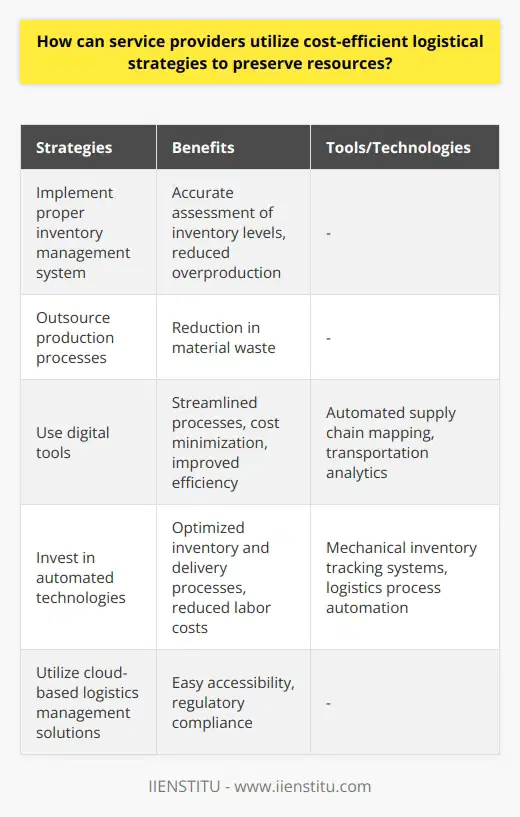
How can individuals and organizations enhance customer satisfaction through seamless service?
Service and customer satisfaction have become increasingly intertwined over recent years as businesses aim to differentiate themselves in an increasingly competitive market. Providing a seamless service experience requires understanding customer expectations, their attitude towards service, and how each interaction can be customized to create an effortless, positive experience.
One approach organizations can take to enhance customer satisfaction through a seamless service is to invest in technology. Technology is essential in providing a more cohesive and intuitive customer service experience. Moreover, it allows customers to interact with a business in their preferred way via a mobile app, web contact form, or online chat.
Another effective way to enhance customer satisfaction is to hire and train experienced and knowledgeable customer service agents. Good customer service personnel can be trained to best utilize technology and quickly respond to customer inquiries. Additionally, customer service agents should be able to identify, anticipate, and address all customer needs to ensure they are satisfied with the service they receive.
Organizations should also take proactive measures to maintain customer satisfaction throughout the customer experience. This includes providing clear information on how customers can make queries or complaints, how long to expect resolution, and what steps can be taken for further assistance. Customers should also have access to feedback mechanisms so that their views are heard and acted upon levels.
Finally, organizations should strive to develop a company-wide culture of customer service. By ensuring that all employees recognize the importance of customer satisfaction and understand the importance of using the best practices to meet customers’ needs, the organization can create a consistent and high-quality service experience.
In conclusion, to enhance customer satisfaction through a seamless experience, organizations must invest time, resources, and technology to ensure that all interactions are customized, efficient, and, ultimately, satisfactory. This includes investing in technology, hiring and training experienced and knowledgeable customer service personnel, taking proactive steps to ensure customer satisfaction throughout the entire service experience, and developing a company-wide customer service culture. Such an effort results in a delighted customer who will be more willing to purchase from the organization and recommend others to do the same.

How does logistics contribute to customer satisfaction?
Logistics' Role in Satisfying Customers
Efficient logistics management plays a crucial role in achieving customer satisfaction, as it ensures timely and accurate delivery of products and services. At the core of customer satisfaction lies the ability to fulfill their needs, and logistics serves as the backbone to accomplish this goal.
Influence of Delivery Speed
One way logistics contributes to customer satisfaction is through quick and reliable delivery of products, fostering trust and loyalty among clients. By optimizing the supply chain and streamlining transportation, an organization can effectively meet customers' expectations.
Handling of Product Returns
A robust logistics system should also cater to product returns or replacements, as this element can greatly impact customer satisfaction. Easing the return process and providing transparent communication about refund or replacement policies can encourage customers to continue shopping with the brand.
Inventory Management
Efficient inventory management results in improved customer satisfaction by ensuring products are always in stock and ready for delivery. By adopting advanced inventory control practices, businesses can avoid stockouts or surpluses and, consequently, maintain a positive relationship with customers.
Adaptability to Customer Needs
Logistics systems that can adapt to varying customer preferences and requirements foster customer satisfaction. For instance, offering flexible delivery options, such as same-day or express shipping, allows businesses to accommodate diverse clientele.
Technology Integration
Integrating technology within logistics operations can enhance customer satisfaction by offering transparency and real-time data on product delivery. By providing customers with tracking information and timely updates, organizations can keep clients informed and satisfied throughout the entire purchasing process.
Environmentally Friendly Practices
Lastly, environmentally conscious customers appreciate logistics systems that prioritize greener operations, such as reducing waste and promoting environmentally friendly packaging or transportation methods.
In conclusion, effective logistics management directly impacts customer satisfaction by ensuring the timely and accurate delivery of products, seamless return processes, efficient inventory management, and adaptability to diverse customer needs. Embracing technology and eco-friendly practices further contributes to meeting customer expectations and fostering loyalty.
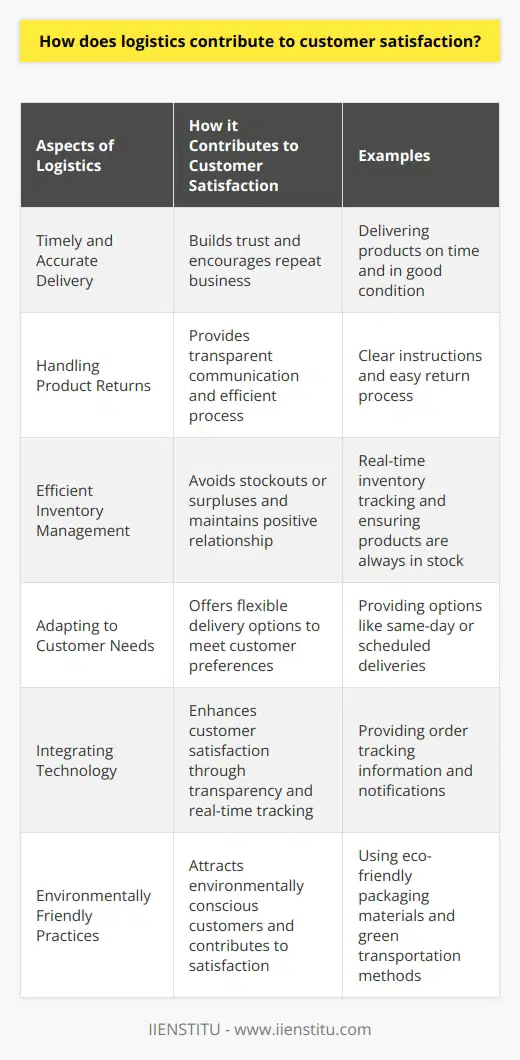
Why is supply chain management important in customer satisfaction?
Importance of Supply Chain Management
Supply chain management (SCM) plays a critical role in ensuring customer satisfaction. With an evolving global economy, organizations need to implement effective supply chain strategies. This helps satisfy customer expectations while maintaining profitability and competitiveness.
Efficiency and Timeliness
A well-managed supply chain ensures timely delivery of products to customers. Efficient operations and logistics planning result in reduced lead times, which ultimately pleases consumers. When customers receive their orders quickly and reliably, they are more likely to remain loyal to the brand.
Quality and Consistency
Customers expect consistent product quality, and SCM greatly impacts this aspect. Proper inventory management and supplier relationships contribute to ensuring high-quality products reach the customers. A supply chain that prioritizes quality control measures will satisfy customers and promote brand awareness.
Cost-Effectiveness
SCM helps reduce operational costs, leading to competitive pricing for customers. By implementing cost-effective strategies, such as bulk purchasing, organizations can offer their products at lower prices, attracting more customers. Cost savings passed on to the consumers can significantly improve their satisfaction levels.
Adaptability and Flexibility
An adaptive supply chain can quickly respond to changes in customer demands and preferences. The ability to forecast demand accurately and adjust production levels accordingly ensures the right products are available for consumers. This flexibility enables organizations to meet customer requirements while minimizing wastage, which ultimately leads to greater satisfaction.
Enhancing Communication
Effective communication flow within the supply chain keeps all parties informed about product statuses and potential issues. By staying proactive in addressing challenges and sharing information, organizations can effectively troubleshoot and optimize their processes. This leads to improved customer experiences, as they feel well-informed about the progress of their orders.
In conclusion, supply chain management is crucial in fostering customer satisfaction. A well-executed supply chain strategy directly impacts various aspects of a customer's experience, including product quality, cost, and timeliness of delivery. Consequently, organizations must prioritize efficient, adaptive, and communicative supply chain management to meet consumer expectations and boost satisfaction levels.
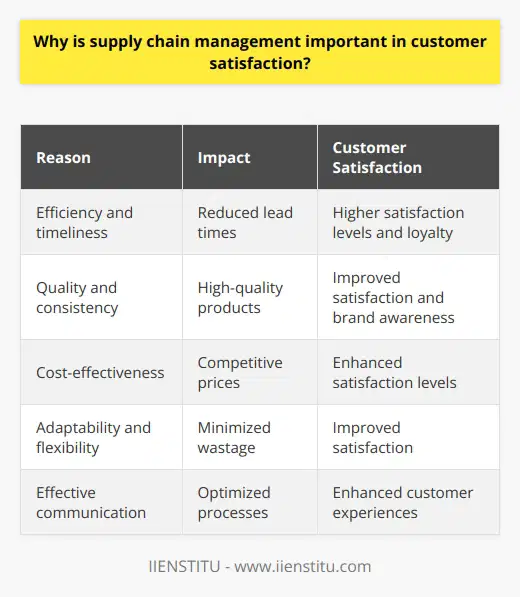
How is customer service related to logistics management?
The Connection between Customer Service and Logistics Management
Customer service is closely linked to logistics management in many aspects, as both areas aim to provide value and satisfaction to the customer. The relationship between these two fields is discussed below.
Efficiency in Delivery Timings
One of the primary concerns in logistics management is the timely delivery of products and services. Efficient logistics management ensures the punctual arrival of goods, which ultimately impacts customer satisfaction. The faster a product reaches a customer, the higher their satisfaction levels will be. By coordinating schedules, routes, and transportation methods, logistics management directly contributes to fulfilling customer expectations.
Accurate Inventory Management
Logistics management revolves around maintaining appropriate inventory levels to cater to customer demands without causing excessive storage costs. An effective logistics process involves balancing supply and demand, ensuring that the right products are available for customers when they need them. Efficient inventory management helps to minimize stockouts and consistently meet customers' needs, thus enhancing their overall experience.
Transparent Communication
One of the requirements of excellent customer service is clear communication with customers. Logistics management plays a vital role in providing transparency about the status of orders, delivery timings, and potential delays. Customers appreciate knowing the whereabouts of their packages, and this is made possible through a well-managed logistics process. By offering regular updates and proactive responses to queries, logistics management fosters trust and loyalty among customers.
Handling Returns and Exchanges
Another area in which customer service and logistics management overlap is the handling of returns and exchanges. Efficient logistics processes should allow for seamless returns or exchanges, ensuring that customers are not inconvenienced. The smoother the process, the more likely customers are to perceive the business as customer-centric and continue their patronage.
In conclusion, the connection between customer service and logistics management is evident through various factors such as efficient delivery, accurate inventory management, transparent communication, and a smooth returns process. By ensuring that logistics management functions are carefully planned and executed, businesses can enhance customer satisfaction and build long-lasting relationships.
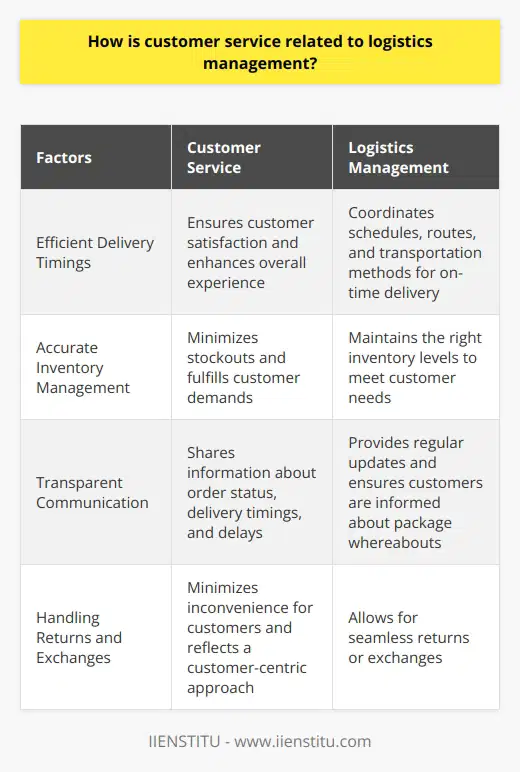
How do you satisfy customers when it comes to logistics?
Understanding Customer Needs
To satisfy customers when it comes to logistics, it is crucial to first understand their specific needs and requirements. This can be achieved by conducting market research and surveys to gather feedback and preferences from the target audience. Engaging in direct communication with customers can also help in identifying their expectations and anticipating potential issues.
Tailoring Services
Once customer needs are identified, logistics providers should tailor their services accordingly, focusing on efficiency, reliability, and speed. Customization can range from offering multiple shipment options and tracking features, to providing personalized delivery services that cater to specific customer preferences. By ensuring that the logistics process is aligned with the customer's demands, a higher level of satisfaction can be achieved.
Technological Advancements
Leveraging technological advancements is another way to improve customer satisfaction in logistics. Implementing advanced supply chain management software, artificial intelligence (AI), and machine learning (ML) can lead to greater efficiency and precision in handling shipments. Furthermore, embracing digital transformation and automation can help streamline operations, reducing the risk of human errors and enhancing the overall customer experience.
Transparency and Communication
Maintaining transparency and open communication with customers is essential to building trust and ensuring their satisfaction. Providing regular updates on shipment status, expected delivery dates, and any potential delays can alleviate customer concerns and help create a sense of confidence in the logistics service. Furthermore, being responsive to customer inquiries and feedback can help resolve issues promptly and foster a healthy client relationship.
Sustainability and Ethical Practices
In today's increasingly eco-conscious world, customers often consider the environmental and social impact of a company's logistics practices when choosing a service provider. Therefore, adopting sustainable and ethical practices throughout the supply chain, such as reducing carbon emissions, using eco-friendly packaging materials, and ensuring fair labor conditions can contribute to a more positive customer perception and, consequently, more satisfied clients.
In conclusion, satisfying customers in the logistics industry requires a multifaceted approach that encompasses understanding customer needs, tailoring services, utilizing technological advancements, maintaining transparency, and adopting sustainable practices. By consistently delivering value and exceeding customer expectations, logistics providers can ultimately foster long-lasting relationships and ensure their clients' satisfaction.
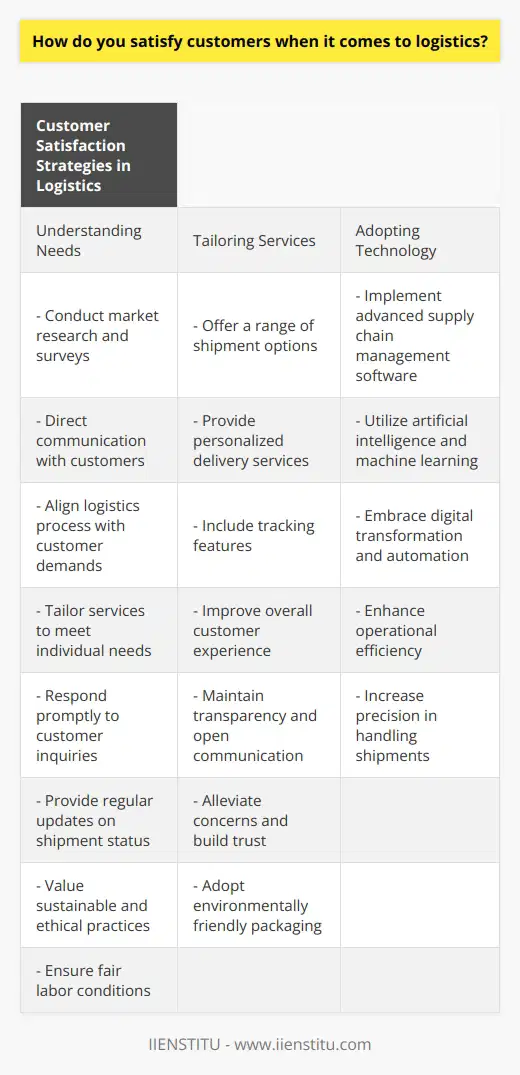
What role does effective communication play in ensuring optimal supply chain management and customer satisfaction?
Role of Effective Communication in Supply Chain Management
Effective communication plays a crucial role in optimal supply chain management by facilitating seamless coordination among all stakeholders. Supply chains are complex networks consisting of manufacturers, suppliers, distributors, and retailers, all working together to deliver products and services to customers. In such a highly interdependent environment, clear and concise communication helps to ensure timely flow of information, enabling cost-effective and efficient operations.
Streamlining the Decision-Making Process
Excellent communication aids in quicker and better decision-making at every level of the supply chain. By sharing accurate information in a timely manner, organizations can avoid delays, minimize the risk of errors, and make well-informed decisions regarding resource allocation, production schedules, and transportation plans.
Enhancing Collaboration Among Stakeholders
Collaboration is essential for the success of any supply chain, and effective communication is the foundation of robust collaboration. By promoting open channels of communication, transparency, and trust, organizations can foster stronger relationships with suppliers, partners, and customers, resulting in improved cooperation, knowledge sharing, and win-win outcomes for all parties involved.
Reducing Potential Conflicts
Disagreements and conflicts can arise in the supply chain due to a lack of communication or misunderstandings between parties. By ensuring transparent and consistent communication, organizations can prevent potential conflicts or resolve them at an early stage, maintaining an environment of harmony and cooperation.
Achieving Customer Satisfaction
Finally, effective communication is vital to achieving customer satisfaction. By communicating clearly and promptly with customers, organizations can address their concerns, gather valuable feedback, and provide them with relevant information regarding product availability, delivery status, and order updates. Engaged customers are more likely to develop loyalty, leading to long-term business relationships and repeat purchases.
In summary, effective communication is essential in order to ensure optimal supply chain management and customer satisfaction. Employing clear, concise, and timely communication strategies enables organizations to streamline decision-making, strengthen collaboration, prevent conflicts, and achieve customer satisfaction, resulting in a more efficient, profitable, and customer-centric supply chain.

How can logistics management help in reducing order fulfillment time and enhancing customer experience?
Reducing Order Fulfillment Time
Effective logistics management plays a vital role in reducing order fulfillment time, which directly enhances customer experience. By streamlining supply chain processes and implementing advanced technology solutions, companies can achieve quicker product delivery and increased efficiency.
Inventory Management and Demand Forecasting
Efficient inventory management and demand forecasting allow organizations to maintain appropriate stock levels, minimize stockouts, and reduce lead time. Accurate demand forecasting facilitates proper scheduling, effective resource allocation, and enhanced coordination among various supply chain components, thus reducing order fulfillment time.
Transportation Optimization
Utilizing transportation optimization strategies, such as improved routing, expedited shipping, and consolidation of shipments, helps companies minimize the transportation time and cost. These strategies ensure timely and accurate order delivery, which is essential for a positive customer experience.
Warehouse Automation
Integrating warehouse automation solutions, such as robotics and automated storage and retrieval systems (AS/RS), can significantly improve the speed and accuracy of order processing. Automation technologies enable companies to minimize errors and delays, resulting in streamlined order fulfillment and a better customer experience.
Vendor Collaboration
Building strong relationships and collaboration with vendors, partners, and retailers can have a substantial impact on order fulfillment time. Working closely with these stakeholders ensures timely procurement of raw materials and components, as well as seamless integration of the entire supply chain.
Improved Visibility and Communication
Last but not least, greater visibility and communication within the supply chain are vital to reducing order fulfillment time. Utilizing technologies, such as the Internet of Things (IoT) and real-time data analytics, allows companies to monitor and respond to fluctuations in demand, ensuring seamless end-to-end supply chain execution and improved customer satisfaction.
In conclusion, logistics management encompasses several crucial factors in reducing order fulfillment time and enhancing customer experience. Companies should focus on inventory management, demand forecasting, transportation optimization, warehouse automation, vendor collaboration, and improved visibility to achieve a competitive advantage, improve customer satisfaction and ultimately, drive growth.
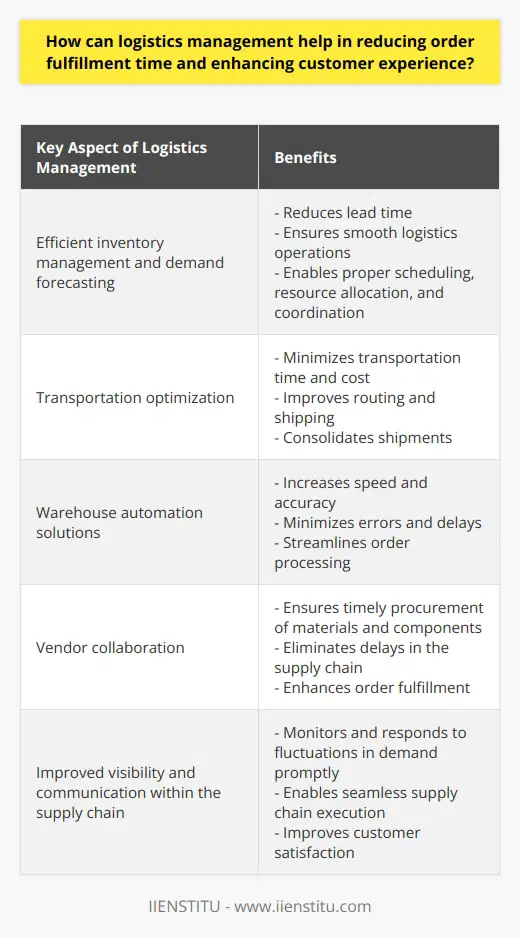
How can incorporating technology in logistics operations lead to improved customer satisfaction?
Incorporating Technology for Optimization
To begin with, incorporating technology in logistics operations streamlines processes, thus leading to increased efficiency. By leveraging advanced software systems, companies can automate many time-consuming tasks and processes, such as dispatching, tracking and tracing, and inventory management. Automation allows for quicker communication and coordination among various departments within a logistics organization, making it easier to satisfy customer demands and expectations.
Enhanced Tracking and Transparency
Furthermore, incorporating technology enables companies to offer enhanced tracking and transparency to customers. By utilizing real-time tracking systems, logistics companies can provide up-to-date information on shipment statuses and estimated delivery times. This enhanced communication offers customers greater visibility into their orders and fosters trust in the logistics provider. In addition, making such data accessible through user-friendly online platforms and mobile applications offers customers the convenience of tracking their shipments anytime, anywhere.
Personalized Service Through Data Analysis
Moreover, the adoption of technology in logistics operations allows for the collection and analysis of large amounts of data. This data can be harnessed for better decision-making and personalized service offerings. By gathering detailed information about customer preferences, logistics companies can tailor their operations to better suit their clients' needs, further contributing to improved customer satisfaction. The insights gained from data analysis can also help logistics providers identify potential issues and devise proactive solutions, thereby preventing delays and dissatisfaction.
Environmentally Conscious Operations
Lastly, incorporating technology in logistics operations can lead to more environmentally conscious practices, ultimately contributing to improved customer satisfaction. By employing advanced routing algorithms and optimizing delivery schedules, logistics companies can reduce fuel consumption and greenhouse gas emissions. Such initiatives not only promote operational efficiency but also demonstrate a commitment to sustainable practices, which can be appreciated by environmentally conscious customers.
In conclusion, incorporating technology in logistics operations paves the way for increased efficiency, greater transparency, personalized service, and environmentally friendly practices. These elements work together to promote improved customer satisfaction, ensuring logistics providers remain competitive in the ever-evolving marketplace.
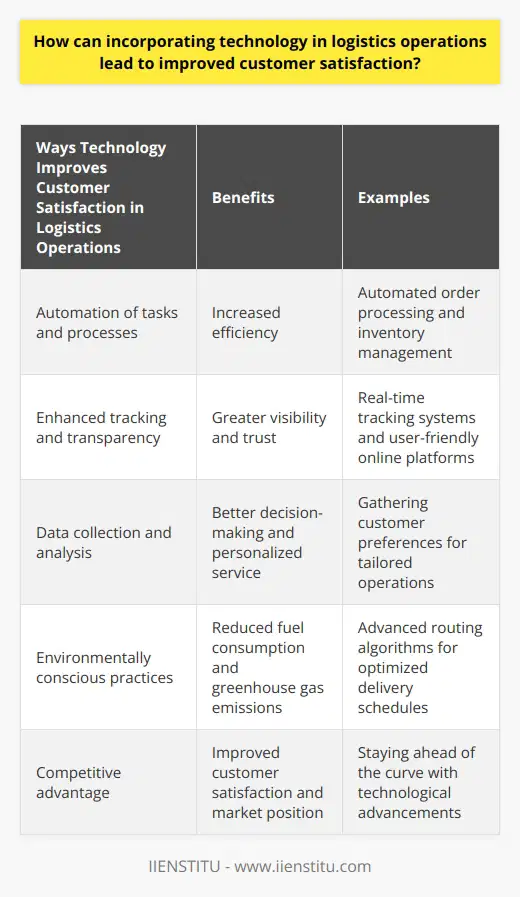
In what ways can efficient inventory management impact customer satisfaction?
Efficient Inventory Management and Customer Satisfaction
Role of Inventory Management
Efficient inventory management plays a critical role in determining customer satisfaction rates. By ensuring adequate stock levels, businesses can meet customer demands promptly, avoiding delays or stockouts. Proper inventory management directly contributes to higher customer satisfaction by increasing the availability and accessibility of products and services.
Optimization through Technology
Inventory management systems implement technology to track, analyze, and optimize inventory levels accurately. These systems provide data-driven insights to identify trends and patterns in customer demand, allowing for informed decision-making. As a result, businesses can maintain appropriate stock levels and ensure that products are readily available to meet customer needs.
Balancing Costs and Availability
Striking a balance between carrying costs and product availability is essential for maximizing customer satisfaction. Understocking translates to missed sales opportunities, while overstocking may result in obsolete inventory and wasted resources. An effective inventory management system enables companies to maintain the optimal stock level, reducing the risk of stockouts and excess inventory, which contributes to improved customer satisfaction.
Improved Order Fulfillment
Efficient inventory management reduces lead times and optimizes order fulfillment processes. A streamlined system ensures that customers receive their orders promptly and accurately, leading to positive experiences and increased satisfaction levels. Moreover, such a system can help businesses identify areas for improvement, enabling them to achieve better results in supply chain management and customer service.
Enhanced Responsiveness
With accurate inventory data in hand, businesses can swiftly respond to changing market needs and customer preferences. Proactive inventory management enables companies to react to evolving trends, ensuring the availability of relevant products and services. This adaptability drives customer engagement and satisfaction, positioning businesses for long-term success.
In conclusion, efficient inventory management significantly impacts customer satisfaction by maintaining appropriate stock levels, optimizing order fulfillment, and enhancing responsiveness to market changes. By investing in robust inventory management systems, businesses can ensure they consistently meet customer needs and expectations, leading to higher satisfaction levels and increased customer loyalty.
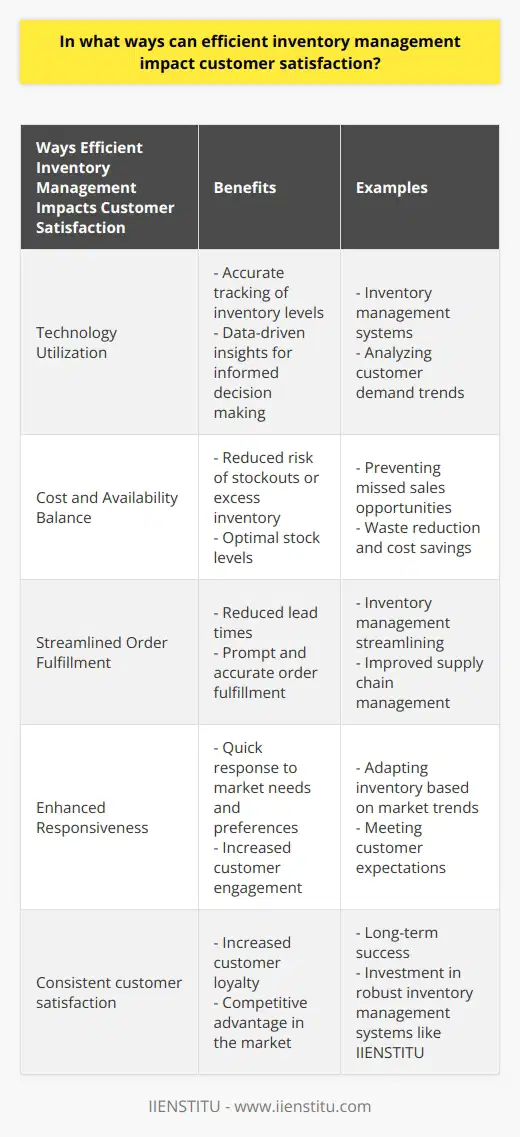
How can data analytics be utilized to optimize logistics performance and enhance customer satisfaction?
Data Analytics in Logistics Performance Optimization
Utilizing data analytics in logistics can significantly improve performance and customer satisfaction through various means. By analyzing historical and real-time data, companies can uncover hidden patterns, correlations, and insights that can lead to better decision-making in logistics management.
Demand Forecasting and Inventory Control
One key area where data analytics can greatly benefit logistics is demand forecasting, where historical sales data is analyzed to predict future demands for products. Accurate demand forecasting enables companies to strike a balance between overstocking and understocking, reducing inventory costs and ensuring a constant supply of products for customers.
Route Optimization
Data analytics can also play a crucial role in optimizing delivery routes. By analyzing data such as traffic patterns, weather conditions, and historical delivery times, companies can determine the most efficient routes for transporting goods. This leads to faster delivery times, lower transportation costs, and ultimately, happier customers.
Resource Allocation
Efficient resource allocation can be achieved through the use of data analytics as well. By analyzing data on the performance of employees, equipment, and other resources, logistics managers can make informed decisions on how best to allocate their resources. This allows for more efficient use of resources, reducing costs and improving overall performance.
Real-Time Tracking and Communications
Data analytics can enhance customer satisfaction by allowing for real-time tracking and improved communication between logistics providers and customers. By analyzing real-time data, such as GPS coordinates and delivery status updates, logistics companies can provide customers with accurate, up-to-date information on their shipments. This transparency not only strengthens customer trust, but also allows for quicker resolution of potential issues.
Personalized Customer Service
Finally, data analytics can be employed to offer a personalized customer experience. By analyzing customer preferences, purchase history, and other data, logistics providers can tailor their services to better meet the unique needs and preferences of each customer. This can include offering customized delivery options, tailored marketing campaigns, or targeted promotions, all of which can contribute to improved customer satisfaction.
In conclusion, the effective utilization of data analytics in logistics enables companies to optimize their performance and enhance customer satisfaction. By embracing data-driven decision-making, businesses can unlock valuable insights and make impactful changes that lead to happier customers and a healthier bottom line.
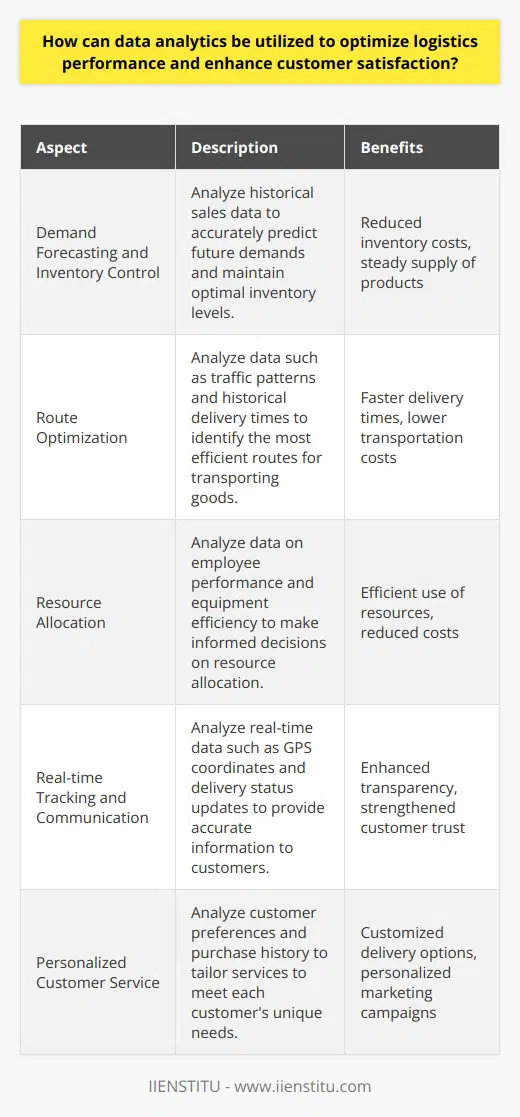
What is the role of logistics in ensuring a positive customer experience across various touchpoints?
Role of Logistics in Customer Experience Enhancement
Logistics Management Significance
Logistics plays a critical role in enhancing the customer experience across various touchpoints by ensuring timely and efficient delivery of products and services. A seamless logistical experience forms the backbone of successful customer interactions, whether it be through online platforms, physical stores or a combination of both.
Efficient Inventory Management
Effective logistics hinges on efficient inventory management, ensuring that products are available when customers need them. Precise tracking of stock levels and forecasting customer demand significantly minimizes the risk of product shortages, keeping customers happy and loyal. By optimizing inventory management, businesses can strengthen the customer experience by reducing wait times and avoiding stockouts.
Swift Order Fulfillment
A well-organized logistics system speeds up the order fulfillment process, cultivating customer satisfaction. Quick and seamless order processing ensures customers receive their purchases swiftly, without any delays or complications. In times of increased market competition, the ability to deliver this level of efficiency is essential for an organization in maintaining a competitive edge and attracting and retaining customers.
Reliable Delivery Services
Reliable delivery services are vitally important for customer experience enhancement as they directly impact perceptions of a business. Accurate tracking and regular communication of shipment status build trust with customers while addressing any potential concerns. By partnering with dependable shipping carriers, organizations can assure that customers receive their purchases securely, solidifying their reputation as a reliable provider.
Seamless Returns Process
An essential aspect of customer satisfaction revolves around the returns process. Streamlining the returns process, including hassle-free product exchanges and refunds, can greatly elevate a customer's overall experience. By establishing clear returns policies and easily accessible channels for raising return requests, logistics can further contribute to positive customer touchpoints.
In conclusion, the role of logistics in ensuring a positive customer experience across various touchpoints is indispensable. A well-functioning logistics system translates into efficient inventory management, swift order fulfillment, reliable delivery services and a seamless returns process, all of which contribute to customer satisfaction and loyalty. As such, businesses should continually refine their logistics operations to improve customer touchpoints and maintain a competitive stance in the market.
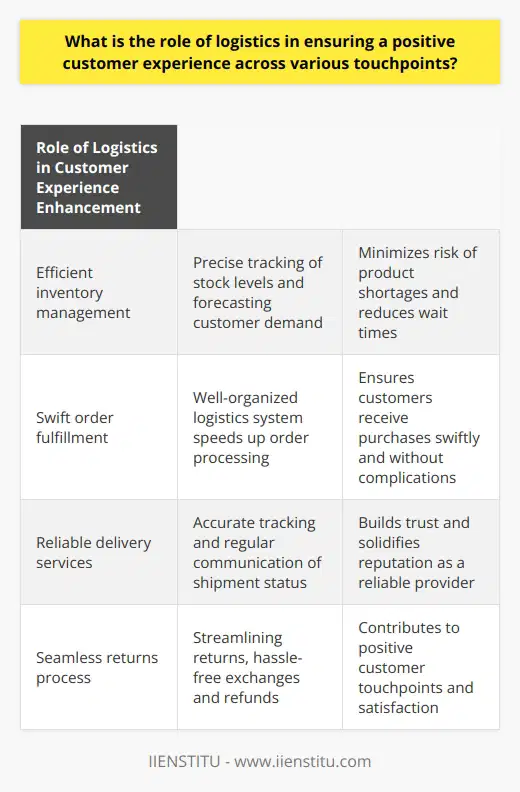
How can effective logistics management contribute to developing long-term customer loyalty and retention?
Understanding the Role of Logistics Management
Effective logistics management plays a crucial role in developing long-term customer loyalty and retention. In today's competitive market, customers expect excellent service, on-time delivery, and reliability when doing business with a company. A well-organized logistics system aids companies in meeting these expectations and ensuring their customers receive their products in a timely and efficient manner.
Efficiency and Reliability
Efficient logistics management involves streamlining processes, reducing delivery times, and facilitating the distribution of products. Cutting down on these inefficiencies helps companies deliver their products at a faster rate, making customers more likely to return for future purchases. Furthermore, when companies can rely on their logistics systems to provide on-time deliveries, they strengthen their reputation for reliability – a key element in customer loyalty.
Quality Control and Tracking
A well-maintained logistics system also includes effective quality control and tracking mechanisms. By ensuring the products delivered are of high quality and conform to the customers' expectations, the company not only gains the customers' trust but also increases the probability of repeat business. Tracking systems allow customers to follow their orders from the warehouse to their doorstep, providing them with peace of mind and keeping them informed at all times.
Adaptability in Changing Market Trends
Logistics management also requires adaptability to respond to changing customer demands and market trends. A company that can adapt to ever-changing market conditions can outpace its competitors by offering innovative solutions, ensuring customer satisfaction and loyalty. An adaptable logistics system demonstrates a company's ability to evolve and grow, which, in turn, cultivates strong customer relationships.
Personalized Service and Responsiveness
Lastly, personalized service and responsiveness to customer inquiries and issues contribute to long-term loyalty and retention. By treating customers as individuals and solving their problems in a timely manner, companies establish strong communication channels, promote customer centricity, and build lasting relationships with their clientele. Efficient logistics management underpins these efforts by minimizing errors and complaints, providing accurate information, and ensuring swift resolutions.
In conclusion, effective logistics management is a crucial factor in developing long-term customer loyalty and retention. By prioritizing efficiency, reliability, quality control, adaptability, and personalized service, companies create an environment where customers know that their needs are consistently met, leading to a strong foundation of trust and satisfaction.
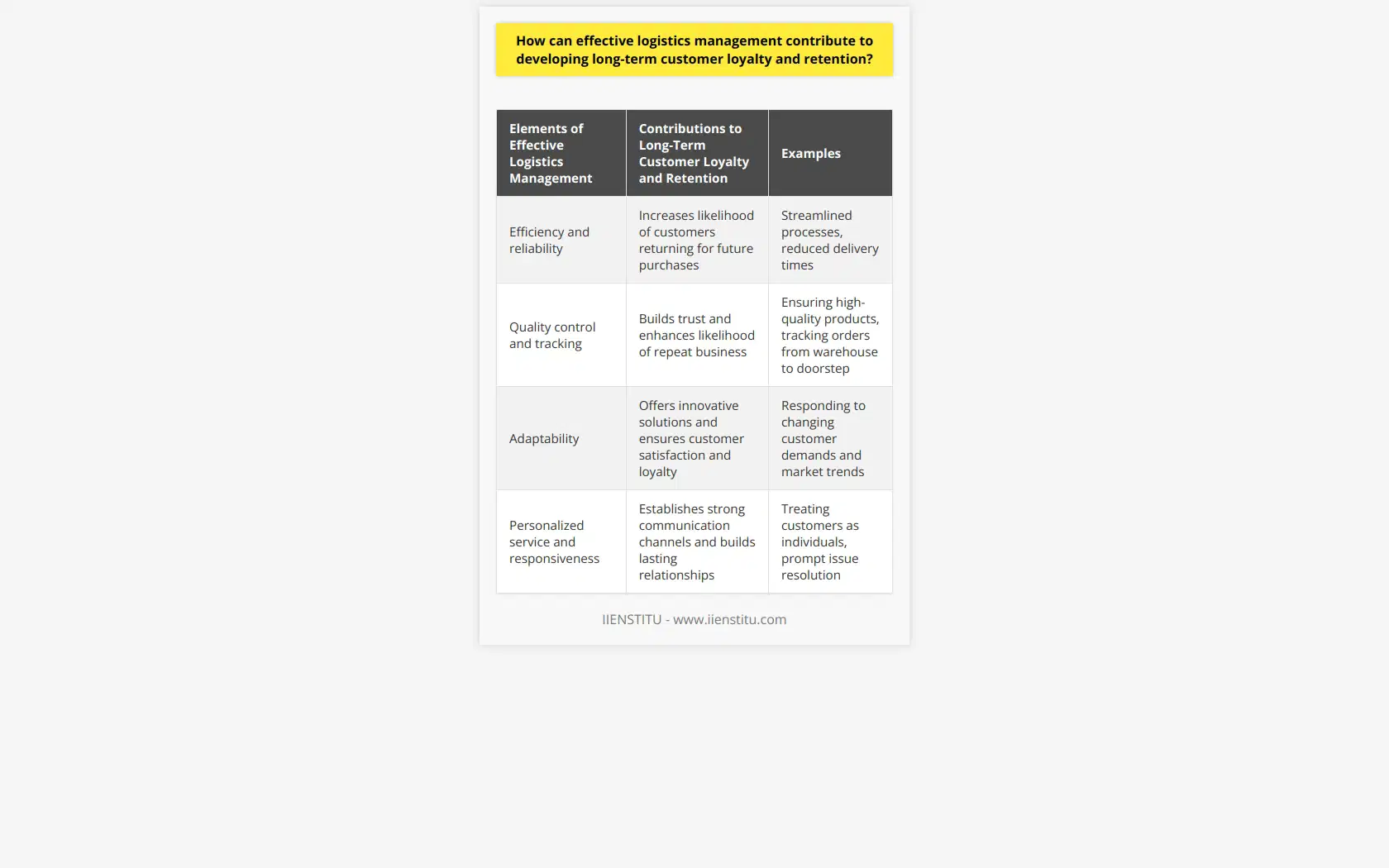
In what ways can an integrated supply chain strategy foster increased customer satisfaction by minimizing delays and errors?
Impact of Integrated Supply Chain Strategy
An integrated supply chain strategy can remarkably contribute to increased customer satisfaction by minimizing delays and errors. One crucial aspect of such an approach is cross-functional coordination and collaboration, which involves sharing data and information between different departments and stakeholders (Das & Kanchan, 2015). This information sharing can help businesses to predict and respond more efficiently to changes in customer demand or potential disruptions in the supply chain, ensuring swift product delivery with minimal errors.
Efficiency in Order Fulfillment
Another pivotal component of an integrated supply chain strategy is the implementation of automated technologies and real-time data analytics to optimize order fulfillment and tracking. These technological advancements enable businesses to better monitor and control their inventory levels, reducing instances of stockouts or overstocks, which directly impacts customer satisfaction (Ivanov, 2015). Furthermore, real-time order tracking and status updates provide transparency in the supply chain, allowing customers to stay informed about the whereabouts of their purchases.
Lean Supply Chain Management
A lean supply chain management approach is also an integral part of an integrated strategy. This methodology focuses on reducing waste and non-value-added activities within the supply chain by fostering a continuous improvement culture (Krajewska & Ritzman, 2005). Such an approach can lead to streamlined processes, quicker turnaround times, and more reliable delivery schedules, ultimately ensuring a higher level of customer satisfaction. Lean principles aim to maximize value for customers by reducing the time from order placement to product delivery.
Improved Forecasting and Demand Planning
Effective demand planning and forecasting are essential elements of an integrated supply chain strategy. Organizations can leverage historical data, market trends, and predictive analytics to create accurate demand forecasts, enabling them to align production and inventory levels with customer expectations (Wieland & Wallenburg, 2011). An accurate demand forecast also allows businesses to plan and allocate resources more efficiently, reducing order processing errors and ensuring the right products are available to customers when needed.
Conclusion
In summary, the integration of cross-functional collaboration, technological advancements, lean management principles, and effective demand planning greatly contributes to a more agile and robust supply chain. This ultimately fosters increased customer satisfaction by minimizing delays and errors while simultaneously maximizing the overall value for customers.
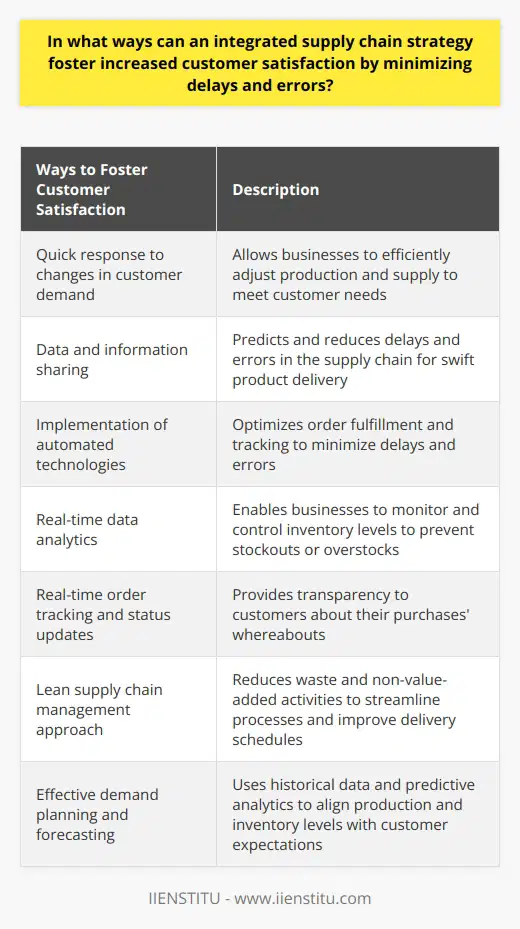
How does the implementation of a robust logistics network help improve overall customer satisfaction?
Impact on Customer Satisfaction
The implementation of a robust logistics network can have several positive effects on overall customer satisfaction. With efficient logistics, companies can streamline their supply chain processes and ensure that customer orders are fulfilled promptly and accurately.
Delivery Timeliness
One of the primary benefits of a robust logistics network is the improvement in delivery time and punctuality. Customers often expect quick deliveries, and in today's fast-paced world, long waiting periods can lead to dissatisfaction. A well-organized logistics system can ensure that orders are routed and dispatched in a timely manner, thus reducing delivery times and enhancing customer satisfaction.
Order Accuracy
Another benefit of efficient logistics is the improved accuracy of orders. By optimizing inventory management and distribution processes, companies can minimize errors and discrepancies in orders, ensuring that customers receive the correct products without any issues. This is crucial in maintaining customer trust and loyalty, as mistakes can lead to disappointment and dissatisfaction.
Order Tracking and Transparency
A robust logistics network also allows for better order tracking and transparency. Customers increasingly demand real-time updates on the whereabouts of their orders. Through the use of advanced technology and comprehensive logistics management systems, companies can provide customers with accurate and up-to-date information on their orders' status.
Cost Reduction and Savings
Efficient logistics can result in cost reduction within the supply chain, and these savings can often be passed on to customers. Lower operating costs allow companies to offer more competitive pricing, thus contributing to higher levels of customer satisfaction. Furthermore, by reducing costs, businesses can invest more resources in enhancing product quality and improving customer service.
Environmental Sustainability
Finally, a well-designed logistics network can contribute to environmental sustainability. By adopting eco-friendly practices and minimizing waste, companies can reduce their carbon footprint. As environmental concerns become increasingly important to consumers, businesses that practice sustainable logistics can improve their corporate image, leading to higher customer satisfaction.
In conclusion, the implementation of a robust logistics network plays a crucial role in improving overall customer satisfaction by ensuring timely deliveries, order accuracy, better transparency, cost savings, and environmental sustainability. By making consistent efforts to optimize their logistics systems, businesses can reap the benefits of high customer satisfaction and strengthen their competitive advantage in the market.
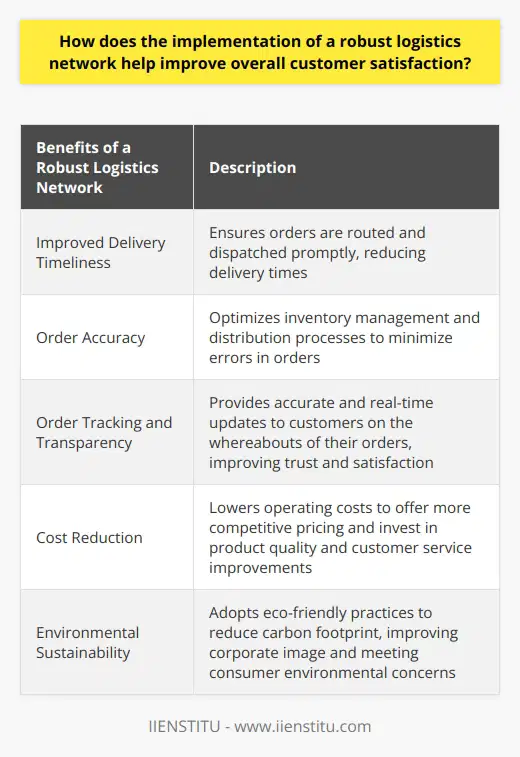
Why is it essential to prioritize customer satisfaction in the logistics and supply chain management process?
Customer-Centric Approach in Logistics
Prioritizing customer satisfaction is essential in the logistics and supply chain management process due to several reasons. A customer-centric approach helps companies to differentiate from the competition, which leads to increased market share and profitability.
Impact on Market Share and Profitability
Focusing on customer satisfaction can pave the way for businesses to attract new customers and retain existing ones. Highly satisfied customers are likely to revisit and make repeat purchases resulting in increased sales revenue and long-term loyalty. Moreover, positive word-of-mouth and recommendations from satisfied customers can lead to a wider consumer base and an improved market position for businesses.
Enhanced Efficiency and Cost Reduction
Meeting customer demands requires optimizing the supply chain to ensure on-time delivery of goods without compromising on quality. This optimization can lead to increased efficiency and cost reduction throughout the logistics process. By adhering to customers’ needs, businesses can identify and eliminate unnecessary costs, thereby increasing overall profitability.
Innovation and Adaptability
A focus on customer satisfaction keeps businesses on their toes and encourages them to innovate and adapt to changing market trends. By continually improving the quality and delivery of products, companies can stay ahead of competition, incorporating new technologies and adjusting their strategies to cater to the evolving needs of today's consumers.
Customer Loyalty and Brand Image
Ensuring customer satisfaction also contributes to building a strong brand image that is vital for the growth and success of businesses. A positive brand image elicits trust and loyalty from customers, making them more likely to recommend the company and its products to others. This creates a strong foundation for businesses to establish a long-lasting relationship with their customers, further solidifying their market position.
In conclusion, prioritizing customer satisfaction in the logistics and supply chain management process is crucial for businesses seeking to excel in the competitive marketplace. By taking a customer-centric approach, companies can not only increase their market share and profitability but also improve efficiency and foster innovation, leading to sustained growth and success.

How can organizations ensure customer-centricity in their logistical and supply chain planning and execution?
Understanding Customer Needs
To ensure customer-centricity in logistical and supply chain planning and execution, organizations must first thoroughly understand their customers' needs and preferences. Conducting market research and analyzing customer data can provide insights into their priorities, enabling companies to tailor their strategies accordingly.
Aligning Supply Chain Processes
Organizations should align their supply chain processes with the needs of their customers to deliver a seamless experience. This may involve optimizing delivery timeframes and finding the most cost-effective shipping methods or ensuring product availability and reducing order cancellations by maintaining adequate inventory levels.
Synchronizing Cross-functional Teams
Involving cross-functional teams, such as sales, marketing, and operations, is crucial for promoting a customer-centric mindset throughout an organization's supply chain. Collaboration between departments will ensure that all team members work together in a synchronized manner to meet customer expectations consistently. Regular communication can also facilitate faster decision-making during unforeseen challenges or disruptions.
Investing in Technology
Incorporating advanced technologies can significantly enhance an organization's ability to meet customer demands. Technologies such as artificial intelligence-driven demand forecasting, warehouse automation, and real-time inventory management systems can enable companies to provide accurate and timely information to customers about their orders throughout the supply chain process. These tools can also reduce lead times, minimize stockouts, and improve overall service levels.
Monitoring Performance Metrics
Regularly tracking and evaluating customer-focused key performance indicators (KPIs), such as on-time delivery rates and order accuracy, can help organizations monitor their progress towards achieving customer-centricity. Reviewing these metrics allows companies to identify gaps in their processes and make data-driven improvements. A strong focus on continuous improvement can ultimately lead to higher customer satisfaction and increased loyalty.
Emphasizing Employee Training
Lastly, investing in employee training and development is essential for fostering a customer-centric culture within an organization. Training programs should reinforce customer-centric best practices and provide employees with the tools they need to effectively prioritize and address customer needs across all aspects of the supply chain.
In conclusion, organizations can ensure customer-centricity in their logistical and supply chain planning and execution by understanding customer needs, aligning processes, fostering collaboration, investing in technology, monitoring performance metrics, and emphasizing employee training. By incorporating these practices, companies can deliver exceptional experiences for their customers and establish long-term, profitable relationships.
